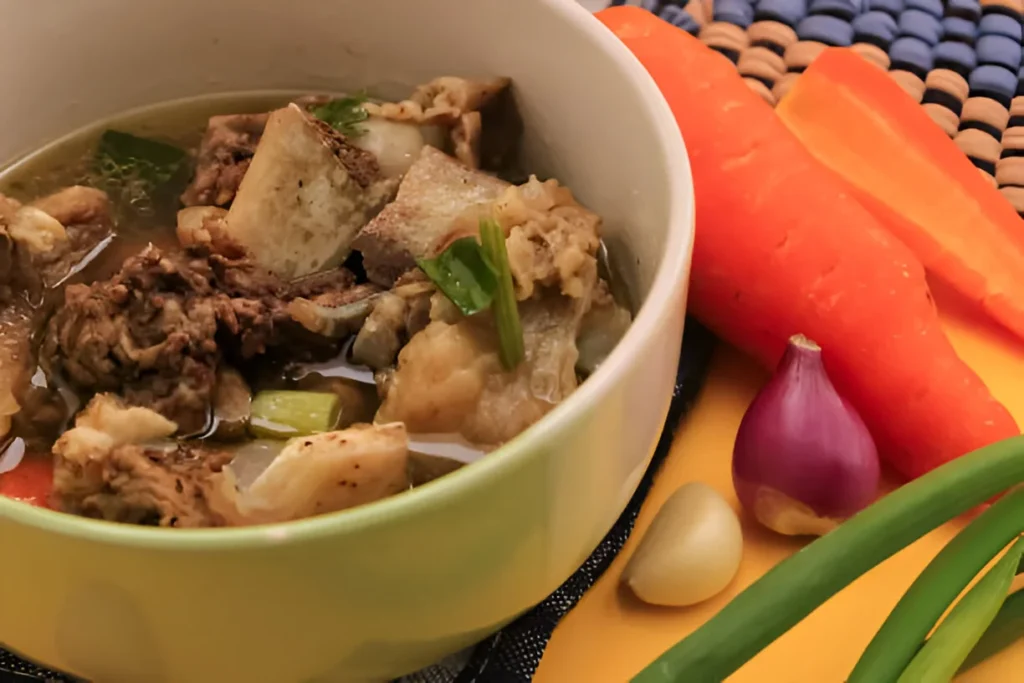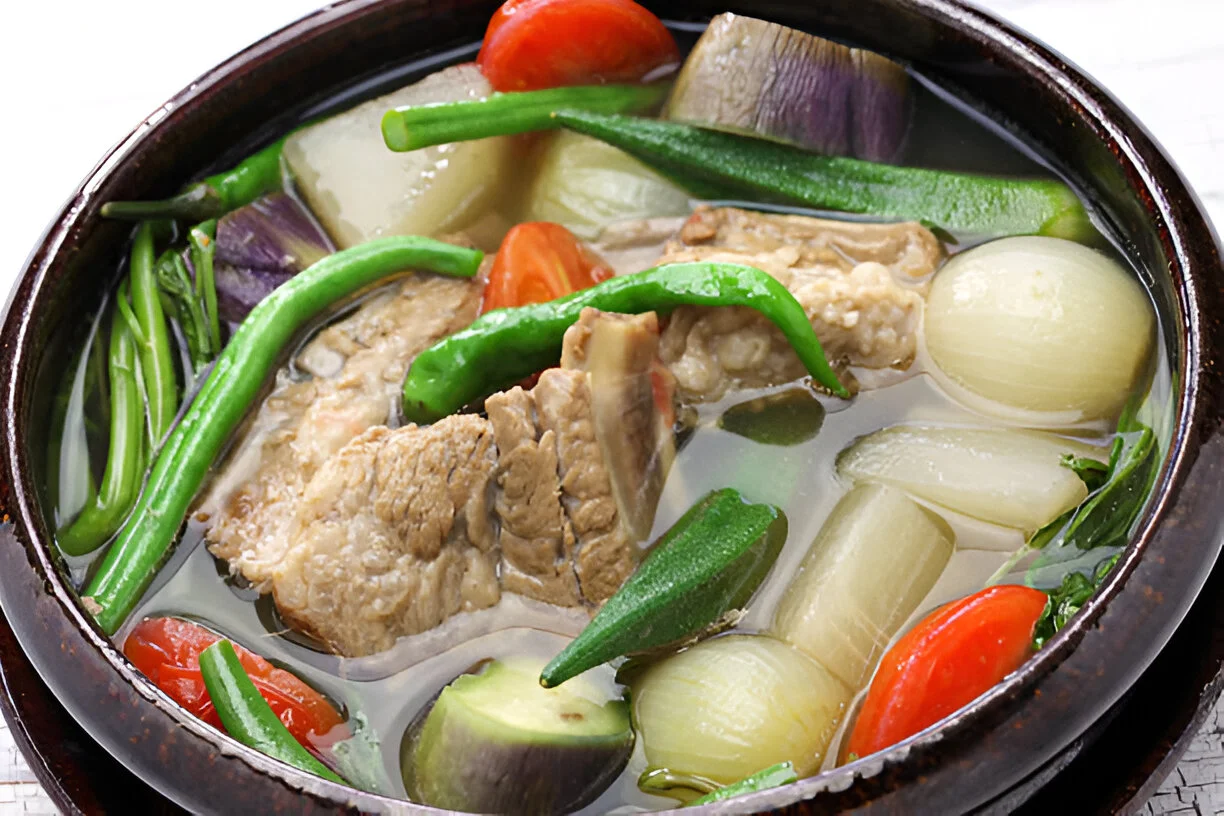Table of content:
Introduction to Sinigang
- What is Sinigang?
- The cultural significance of Sinigang in Filipino cuisine
- Overview of common ingredients
- Key Ingredients for Authentic Sinigang
- Tamarind: The essential souring agent
- Meat Options: Pork, shrimp, or beef
- Vegetables: Water spinach, radish, tomatoes, and onions
- Seasoning: The role of fish sauce and other spices
- Step-by-Step Cooking Instructions
- Preparing the broth: Using tamarind and water
- Cooking the meat: Tips for perfect tenderness
- Adding vegetables: Timing for optimal texture
- Final seasoning: Adjusting flavors for balance
- Variations of Sinigang
- Pork Sinigang: Traditional and beloved
- Shrimp Sinigang: A lighter, seafood version
- Vegan Sinigang: Plant-based alternatives and ingredients
- Regional variations: How different regions in the Philippines tweak the recipe
- Tips for Making the Perfect Sinigang
- Selecting fresh ingredients for the best flavor
- Common mistakes to avoid when cooking Sinigang
- How to adjust the sourness to your taste
- Storing and reheating leftovers effectively
Conclusion
- Recap of the joy of making and eating Sinigang
- Encouragement to experiment with different variations
- Invitation for readers to share their own Sinigang experiences

Introduction to Sinigang
What is Sinigang?
Sinigang is a traditional Filipino soup known for its distinct sour flavor. It is typically made with a variety of meats, such as pork, shrimp, or beef, and is characterized by its use of tamarind or other souring agents, which give it a unique and refreshing taste. The dish is often enjoyed during meals with family and friends, making it a staple in Filipino households.
The Cultural Significance of Sinigang in Filipino Cuisine
Sinigang holds a special place in Filipino culture and cuisine. It is often considered a comfort food, evoking memories of home-cooked meals and family gatherings. The dish reflects the Filipino values of hospitality and togetherness, as it is commonly served during festive occasions and gatherings. Additionally, Sinigang showcases the country’s rich agricultural heritage, utilizing locally sourced ingredients and seasonal produce.
Overview of Common Ingredients
The key ingredients in an authentic Sinigang recipe include:
- Tamarind: The primary souring agent, which can be used in its fresh form or as a concentrated paste.
- Meat: Pork is the most popular choice, but shrimp, beef, or even fish can also be used.
- Vegetables: Commonly includes water spinach (kangkong), radish (labanos), tomatoes, and onions, which add depth of flavor and texture to the soup.
- Seasoning: Fish sauce is often added to enhance the umami flavor, along with salt and pepper to taste.
Key Ingredients for Authentic Sinigang
Tamarind: The Essential Souring Agent
Tamarind is the heart of Sinigang, providing its signature sourness that defines the dish. This tropical fruit can be used in various forms, such as fresh tamarind pods, tamarind paste, or powdered tamarind. The choice of souring agent can significantly affect the flavor profile of the soup. Fresh tamarind offers a bright, vibrant taste, while concentrated forms provide a more intense sourness. Some variations of Sinigang also use other souring agents like green mango, bilimbi, or calamansi for added complexity.
Meat Options: Pork, Shrimp, or Beef
While pork is the most traditional choice for Sinigang, there are plenty of options to suit different tastes:
- Pork: Cuts such as belly or ribs are popular for their rich flavor and tenderness when cooked.
- Shrimp: A lighter alternative, shrimp Sinigang is quick to prepare and offers a delightful seafood twist.
- Beef: Cuts like shank or brisket can also be used for a heartier version of the soup. Each meat brings its unique flavor and texture, allowing for creative variations.
Vegetables: Water Spinach, Radish, Tomatoes, and Onions
The vegetables in Sinigang not only contribute to the dish’s flavor but also enhance its nutritional value. Common vegetables include:
- Water Spinach (Kangkong): This leafy green adds freshness and texture to the soup.
- Radish (Labanos): Its mild sweetness complements the sour broth beautifully.
- Tomatoes: They add a subtle sweetness and depth of flavor to the soup.
- Onions: Used as a base flavor, onions provide a savory foundation for the dish.
Seasoning: The Role of Fish Sauce and Other Spices
Seasoning is crucial in achieving the perfect balance of flavors in Sinigang. Fish sauce (patis) is a traditional ingredient that enhances the umami profile, bringing out the richness of the meat and vegetables. It is usually added towards the end of cooking to prevent it from overpowering the other flavors. Other spices, such as black pepper and salt, can be adjusted to taste, ensuring the soup is well-seasoned without overshadowing the tangy essence of the tamarind.
Step-by-Step Cooking Instructions
Preparing the Broth: Using Tamarind and Water
- Choose Your Souring Agent: If using fresh tamarind, remove the pods and soak them in warm water for about 30 minutes. Once softened, mash the tamarind and strain the mixture to extract the juice.
- Combine Ingredients: In a large pot, add 6-8 cups of water and the tamarind juice (or paste if using). Bring the mixture to a gentle boil.
- Simmer: Allow the broth to simmer for about 10-15 minutes to develop the sour flavor. This creates a flavorful base for your Sinigang.
Cooking the Meat: Tips for Perfect Tenderness
- Add the Meat: Once the broth is ready, add your chosen meat (pork, shrimp, or beef) to the pot. For pork, use cuts like belly or ribs; for beef, shank or brisket works well.
- Boil and Skim: Bring the mixture back to a boil. Skim off any impurities or foam that rise to the surface to keep the broth clear.
- Simmer Until Tender: Reduce the heat and let the meat simmer until tender. Pork typically takes about 45 minutes to an hour, while shrimp cooks much quicker (about 3-5 minutes). If using beef, it may require about 1.5 to 2 hours, depending on the cut.
Adding Vegetables: Timing for Optimal Texture
- Introduce Harder Vegetables First: Once the meat is tender, start by adding harder vegetables like radish and tomatoes. Allow them to cook for about 5-10 minutes.
- Add Leafy Greens Last: Add the water spinach (kangkong) and any other softer vegetables like eggplant or string beans towards the end of cooking. These should only need about 2-3 minutes to wilt and soften without losing their vibrant color and nutrients.
Final Seasoning: Adjusting Flavors for Balance
- Taste the Broth: After all the ingredients are cooked, taste the broth to assess the flavor. This is the perfect time to make adjustments.
- Add Fish Sauce: Stir in fish sauce gradually, starting with 1-2 tablespoons, and adjust according to your preference. This enhances the umami flavor without overpowering the sourness.
- Season to Taste: Finish with salt and pepper to taste, ensuring the flavors are balanced. If the soup is too sour, you can add a pinch of sugar to mellow it out.
Variations of Sinigang
Pork Sinigang: Traditional and Beloved
Pork Sinigang is the most iconic version of this dish, cherished for its rich flavors and comforting qualities. Typically made with cuts like pork belly or spare ribs, it features a savory broth enriched by the sourness of tamarind. This version often includes a variety of vegetables, including water spinach, radish, and eggplant, making it a satisfying meal. It’s commonly served with steamed rice, enhancing the overall dining experience.
Shrimp Sinigang: A Lighter, Seafood Version
Shrimp Sinigang is a delightful twist on the traditional recipe, offering a lighter and fresher alternative. This variation cooks quickly, with shrimp added just a few minutes before serving to maintain its tenderness. The broth retains its signature sourness, complemented by the natural sweetness of the shrimp. Often, this version also includes vegetables like tomatoes and kangkong, making it a perfect option for seafood lovers looking for a refreshing soup.
Vegan Sinigang: Plant-Based Alternatives and Ingredients
Vegan Sinigang provides a delicious plant-based option for those avoiding meat. Instead of pork or shrimp, this version uses tofu or tempeh as the protein source, which absorbs the flavors of the broth beautifully. The traditional souring agent remains the same, and a variety of vegetables can be used, such as mushrooms, zucchini, and leafy greens. This variation maintains the authentic taste of Sinigang while catering to a vegan diet, proving that comfort food can be both delicious and inclusive.
Regional Variations: How Different Regions in the Philippines Tweak the Recipe
Across the Philippines, Sinigang has unique regional adaptations that showcase local ingredients and flavors:
- Sinigang na Baboy sa Bayabas: In the Visayas region, guava is used as the souring agent instead of tamarind, giving the dish a distinct sweetness.
- Sinigang na Isda: In coastal areas, fish such as bangus (milkfish) or tilapia are often used, resulting in a lighter broth that highlights the fresh seafood.
- Sinigang sa Miso: This variation incorporates miso paste, adding depth and umami to the soup, and is particularly popular in regions with a rich fishing culture.
Tips for Making the Perfect Sinigang
Selecting Fresh Ingredients for the Best Flavor
To achieve the most flavorful Sinigang, start with fresh ingredients. Look for ripe tamarind or high-quality tamarind paste, as this is the key to the soup’s signature sourness. Choose fresh vegetables like water spinach, radish, and tomatoes that are vibrant and crisp. When selecting meat, opt for cuts that have a good balance of fat and meat, such as pork belly or ribs, which will enhance the richness of the broth.
Common Mistakes to Avoid When Cooking Sinigang
One common mistake is using sinigang mix instead of fresh tamarind or other souring agents. While convenient, using fresh ingredients allows for better control over the flavor and authenticity of the dish 1. Another mistake is overcooking the vegetables; add them in stages to ensure they maintain their texture and nutrients. Lastly, be cautious with the amount of fish sauce; start with a small amount and adjust to taste to avoid overpowering the dish.
How to Adjust the Sourness to Your Taste
Sinigang is all about achieving the right balance of sourness. If you find the soup too sour, you can add a pinch of sugar to mellow the acidity. Conversely, if you prefer a more pronounced sour flavor, consider adding more tamarind or experimenting with other souring agents like green mango or calamansi. Always taste as you go, adjusting the sourness gradually to suit your palate 1.
Storing and Reheating Leftovers Effectively
To store leftovers, place them in a container with a tight-fitting lid and refrigerate for up to three days2. When reheating, warm the Sinigang in a pot over medium heat, stirring periodically until it reaches an internal temperature of 165°F. Alternatively, you can use the microwave, heating in 2 to 3-minute intervals and stirring well after each interval to ensure even warming 3. Interestingly, many find that Sinigang tastes even better the next day, as the flavors have more time to meld together.
Conclusion
In conclusion, Sinigang is more than just a dish; it embodies the warmth and comfort of Filipino cuisine. The joy of making and eating Sinigang lies in its rich flavors, the delightful sourness from tamarind, and the heartiness of the ingredients. Each bowl serves as a reminder of home, family gatherings, and the love that goes into cooking.
I encourage you to experiment with different variations of Sinigang, whether it’s trying out shrimp, vegan options, or regional twists that highlight local ingredients. Each variation offers a unique taste experience, allowing you to discover new favorites while honoring this beloved classic.
Lastly, I invite you to share your own Sinigang experiences! Whether it’s a cherished family recipe, a memorable meal, or your own creative twist on the dish, your stories contribute to the rich tapestry of Sinigang’s cultural significance. Happy cooking!
